Abstract
An indirect fluorescent-antibody (IFA) technique, which employed adsorbed Behring polyvalent I O antiserum, was used to detect Salmonella spp. in environmental water systems. The IFA method used in this study detected 95% of Salmonella serotypes encountered in human infections in France, with a sensitivity threshold of 7.5 x 10(3) bacteria per ml of wastewater. Specificity was assessed by testing IFA against Salmonella-free seawater and a variety of bacteria other than Salmonella spp. When used to examine raw and chlorinated wastewater over a 2-month period, the IFA method was successful in detecting Salmonella spp. in all 12 of the samples examined, with total numbers determined to be 4.5 x 10(5) to 3.3 x 10(7) salmonellae per 100 ml. In comparison, for the same samples, enumeration by culture, using the most-probable-number technique, was effective in detecting Salmonella spp. in only four of eight raw-water samples and one of four chlorinated water samples tested. Three samples were further tested by using the direct viable count procedure combined with IFA and results showed that 5 to 31.5% of the Salmonella spp. enumerated by this method in chlorinated water were substrate responsive.
Full text
PDF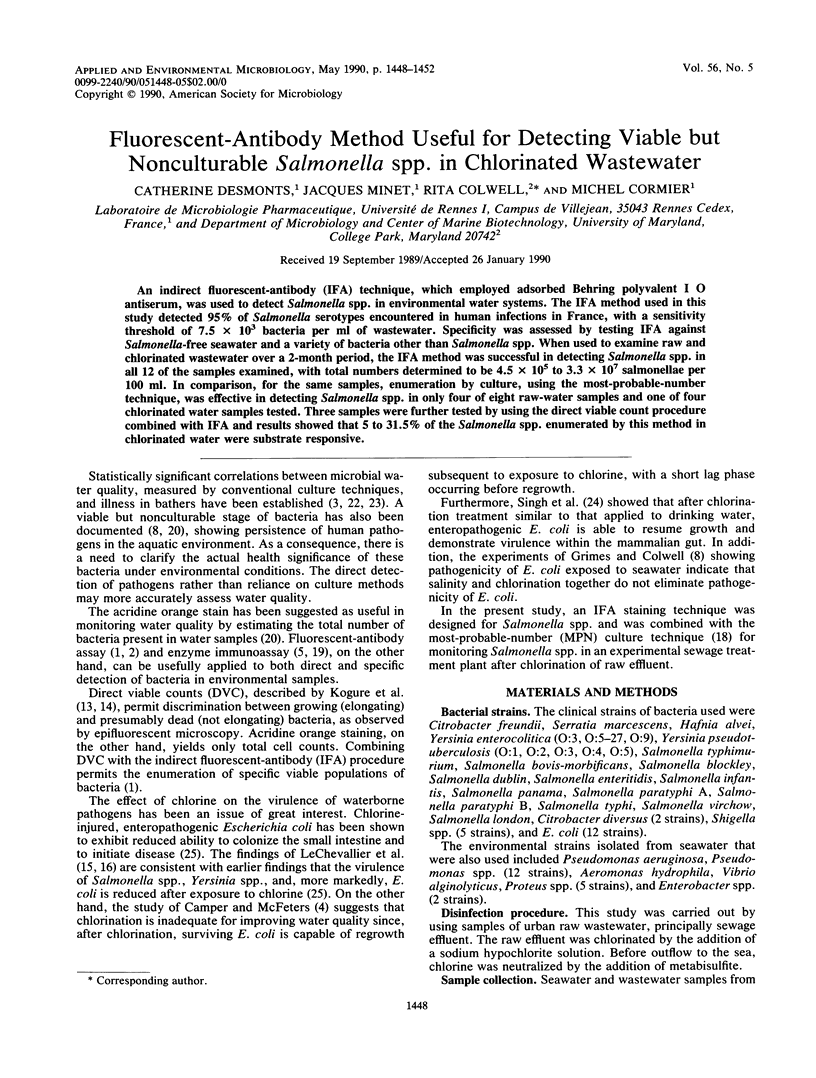
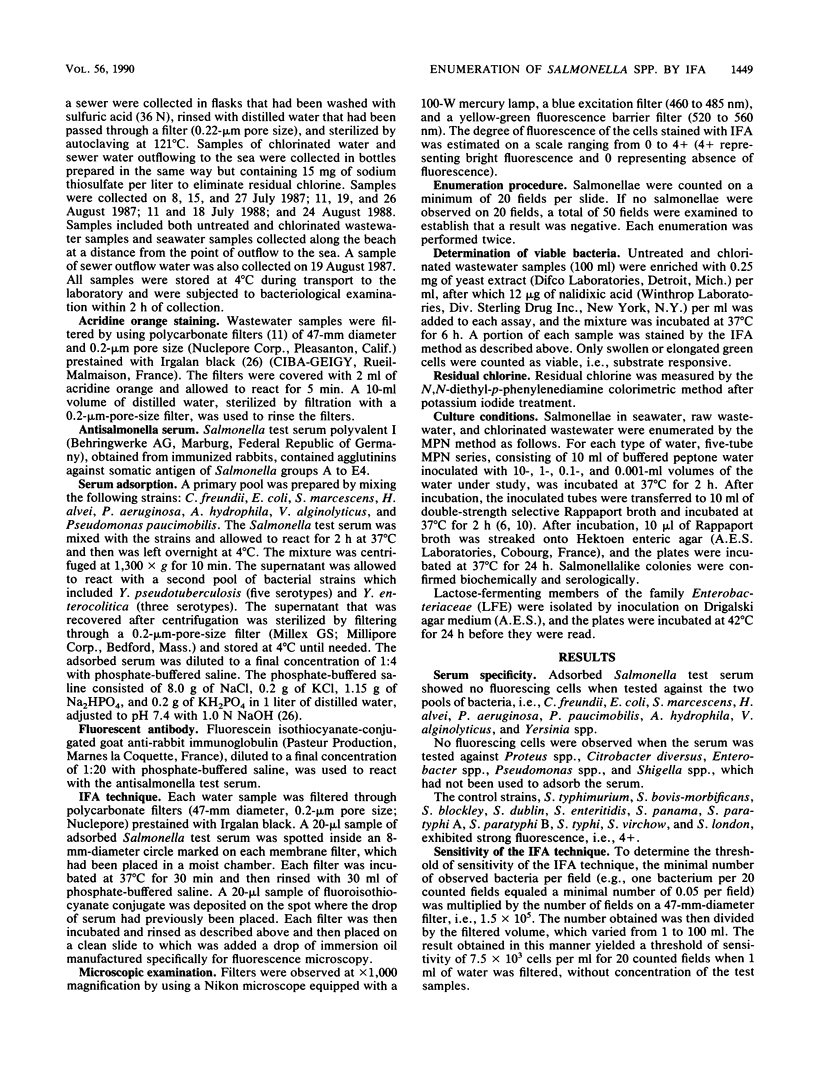
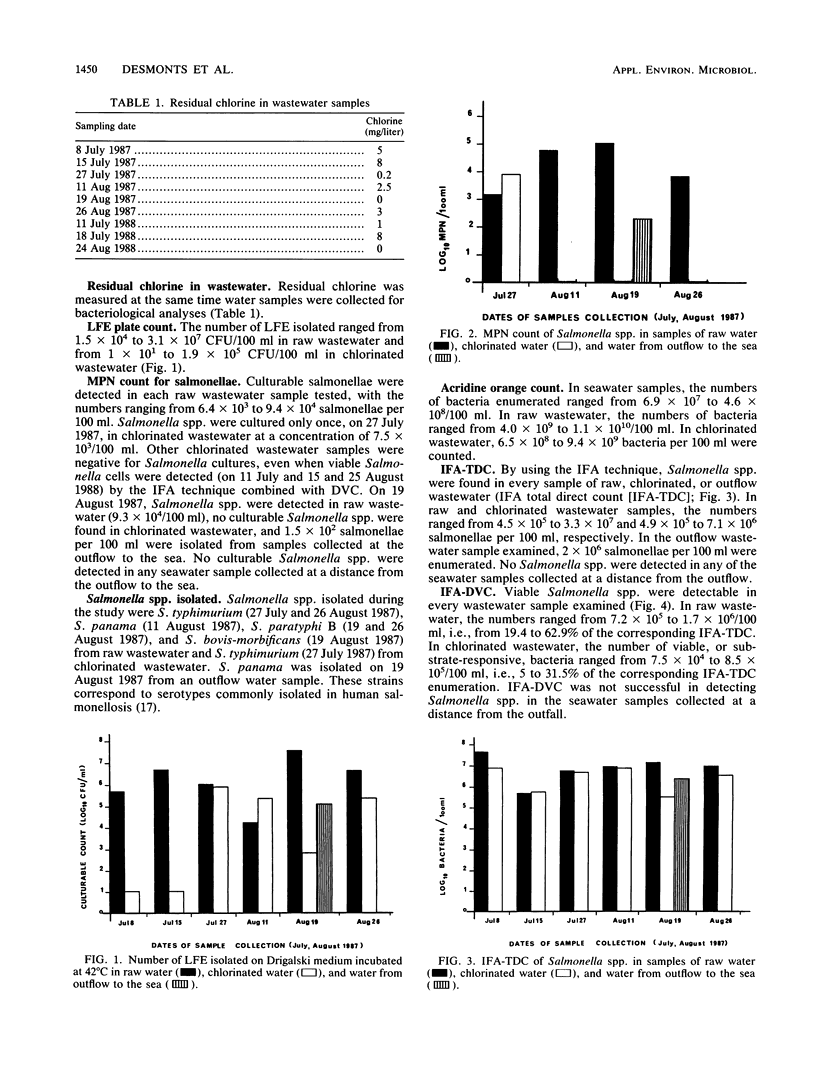
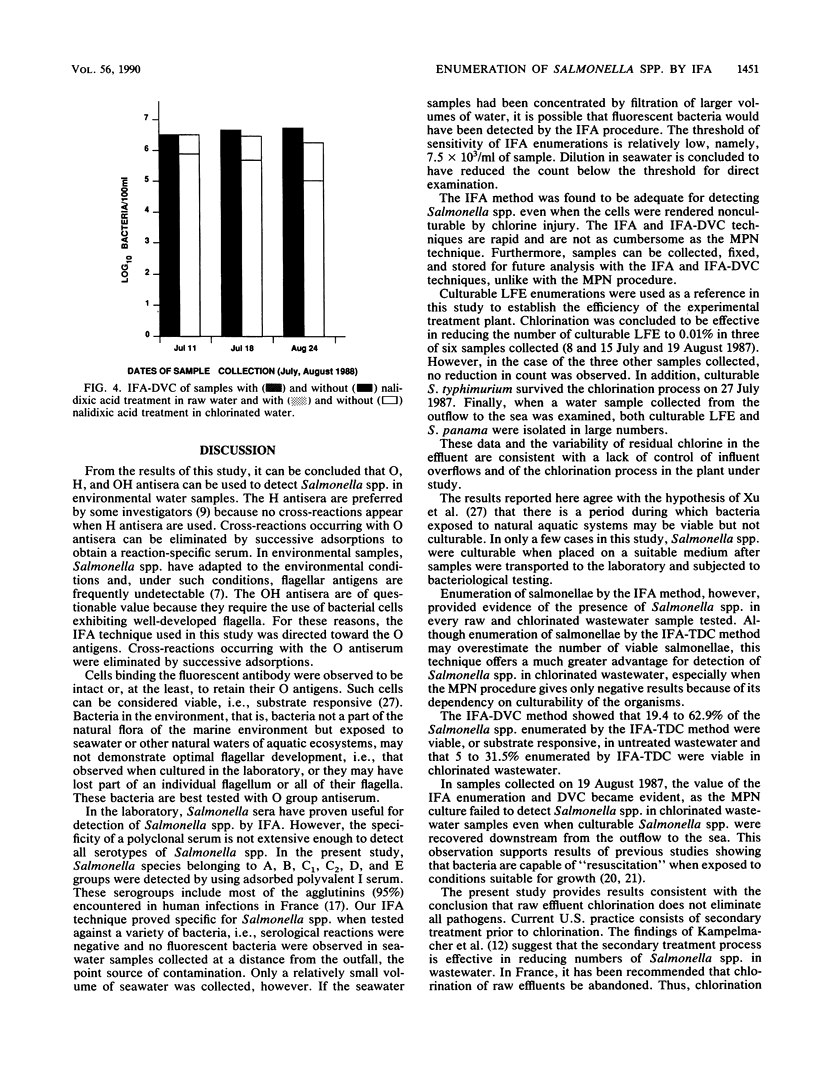
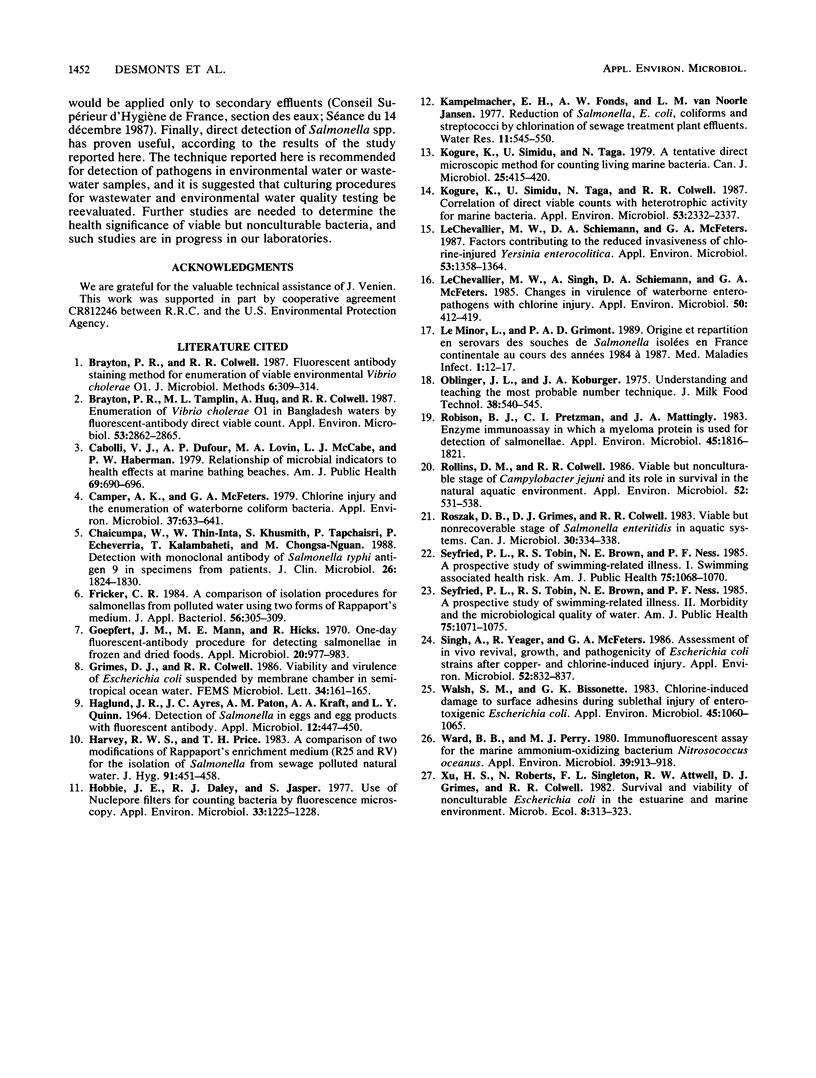
Selected References
These references are in PubMed. This may not be the complete list of references from this article.
- Brayton P. R., Tamplin M. L., Huq A., Colwell R. R. Enumeration of Vibrio cholerae O1 in Bangladesh waters by fluorescent-antibody direct viable count. Appl Environ Microbiol. 1987 Dec;53(12):2862–2865. doi: 10.1128/aem.53.12.2862-2865.1987. [DOI] [PMC free article] [PubMed] [Google Scholar]
- Cabelli V. J., Dufour A. P., Levin M. A., McCabe L. J., Haberman P. W. Relationship of microbial indicators to health effects at marine bathing beaches. Am J Public Health. 1979 Jul;69(7):690–696. doi: 10.2105/ajph.69.7.690. [DOI] [PMC free article] [PubMed] [Google Scholar]
- Camper A. K., McFeters G. A. Chlorine injury and the enumeration of waterborne coliform bacteria. Appl Environ Microbiol. 1979 Mar;37(3):633–641. doi: 10.1128/aem.37.3.633-641.1979. [DOI] [PMC free article] [PubMed] [Google Scholar]
- Chaicumpa W., Thin-Inta W., Khusmith S., Tapchaisri P., Echeverria P., Kalambaheti T., Chongsa-Nguan M. Detection with monoclonal antibody of Salmonella typhi antigen 9 in specimens from patients. J Clin Microbiol. 1988 Sep;26(9):1824–1830. doi: 10.1128/jcm.26.9.1824-1830.1988. [DOI] [PMC free article] [PubMed] [Google Scholar]
- Fricker C. R. A comparison of isolation procedures for salmonellas from polluted water using two forms of Rappaport's medium. J Appl Bacteriol. 1984 Apr;56(2):305–309. doi: 10.1111/j.1365-2672.1984.tb01351.x. [DOI] [PubMed] [Google Scholar]
- Goepfert J. M., Mann M. E., Hicks R. One-day fluorescent-antibody procedure for detecting salmonellae in frozen and dried foods. Appl Microbiol. 1970 Dec;20(6):977–983. doi: 10.1128/am.20.6.977-983.1970. [DOI] [PMC free article] [PubMed] [Google Scholar]
- HAGLUND J. R., AYRES J. C., PATON A. M., KRAFT A. A., QUINN L. Y. DETECTION OF SALMONELLA IN EGGS AND EGG PRODUCTS WITH FLUORESCENT ANTIBODY. Appl Microbiol. 1964 Sep;12:447–450. doi: 10.1128/am.12.5.447-450.1964. [DOI] [PMC free article] [PubMed] [Google Scholar]
- Harvey R. W., Price T. H. A comparison of two modifications of Rappaport's enrichment medium (R25 and RV) for the isolation of salmonellas from sewage polluted natural water. J Hyg (Lond) 1983 Dec;91(3):451–458. doi: 10.1017/s0022172400060496. [DOI] [PMC free article] [PubMed] [Google Scholar]
- Hobbie J. E., Daley R. J., Jasper S. Use of nuclepore filters for counting bacteria by fluorescence microscopy. Appl Environ Microbiol. 1977 May;33(5):1225–1228. doi: 10.1128/aem.33.5.1225-1228.1977. [DOI] [PMC free article] [PubMed] [Google Scholar]
- Kogure K., Simidu U., Taga N. A tentative direct microscopic method for counting living marine bacteria. Can J Microbiol. 1979 Mar;25(3):415–420. doi: 10.1139/m79-063. [DOI] [PubMed] [Google Scholar]
- Kogure K., Simidu U., Taga N., Colwell R. R. Correlation of direct viable counts with heterotrophic activity for marine bacteria. Appl Environ Microbiol. 1987 Oct;53(10):2332–2337. doi: 10.1128/aem.53.10.2332-2337.1987. [DOI] [PMC free article] [PubMed] [Google Scholar]
- LeChevallier M. W., Schiemann D. A., McFeters G. A. Factors contributing to the reduced invasiveness of chlorine-injured Yersinia enterocolitica. Appl Environ Microbiol. 1987 Jun;53(6):1358–1364. doi: 10.1128/aem.53.6.1358-1364.1987. [DOI] [PMC free article] [PubMed] [Google Scholar]
- LeChevallier M. W., Singh A., Schiemann D. A., McFeters G. A. Changes in virulence of waterborne enteropathogens with chlorine injury. Appl Environ Microbiol. 1985 Aug;50(2):412–419. doi: 10.1128/aem.50.2.412-419.1985. [DOI] [PMC free article] [PubMed] [Google Scholar]
- Robison B. J., Pretzman C. I., Mattingly J. A. Enzyme immunoassay in which a myeloma protein is used for detection of salmonellae. Appl Environ Microbiol. 1983 Jun;45(6):1816–1821. doi: 10.1128/aem.45.6.1816-1821.1983. [DOI] [PMC free article] [PubMed] [Google Scholar]
- Rollins D. M., Colwell R. R. Viable but nonculturable stage of Campylobacter jejuni and its role in survival in the natural aquatic environment. Appl Environ Microbiol. 1986 Sep;52(3):531–538. doi: 10.1128/aem.52.3.531-538.1986. [DOI] [PMC free article] [PubMed] [Google Scholar]
- Roszak D. B., Grimes D. J., Colwell R. R. Viable but nonrecoverable stage of Salmonella enteritidis in aquatic systems. Can J Microbiol. 1984 Mar;30(3):334–338. doi: 10.1139/m84-049. [DOI] [PubMed] [Google Scholar]
- Seyfried P. L., Tobin R. S., Brown N. E., Ness P. F. A prospective study of swimming-related illness. I. Swimming-associated health risk. Am J Public Health. 1985 Sep;75(9):1068–1070. doi: 10.2105/ajph.75.9.1068. [DOI] [PMC free article] [PubMed] [Google Scholar]
- Seyfried P. L., Tobin R. S., Brown N. E., Ness P. F. A prospective study of swimming-related illness. II. Morbidity and the microbiological quality of water. Am J Public Health. 1985 Sep;75(9):1071–1075. doi: 10.2105/ajph.75.9.1071. [DOI] [PMC free article] [PubMed] [Google Scholar]
- Singh A., Yeager R., McFeters G. A. Assessment of in vivo revival, growth, and pathogenicity of Escherichia coli strains after copper- and chlorine-induced injury. Appl Environ Microbiol. 1986 Oct;52(4):832–837. doi: 10.1128/aem.52.4.832-837.1986. [DOI] [PMC free article] [PubMed] [Google Scholar]
- Walsh S. M., Bissonnette G. K. Chlorine-induced damage to surface adhesions during sublethal injury of enterotoxigenic Escherichia coli. Appl Environ Microbiol. 1983 Mar;45(3):1060–1065. doi: 10.1128/aem.45.3.1060-1065.1983. [DOI] [PMC free article] [PubMed] [Google Scholar]
- Ward B. B., Perry M. J. Immunofluorescent Assay for the Marine Ammonium-Oxidizing Bacterium Nitrosococcus oceanus. Appl Environ Microbiol. 1980 Apr;39(4):913–918. doi: 10.1128/aem.39.4.913-918.1980. [DOI] [PMC free article] [PubMed] [Google Scholar]


